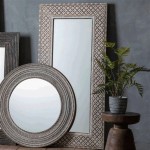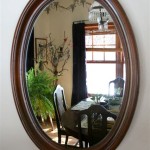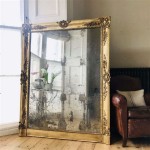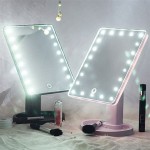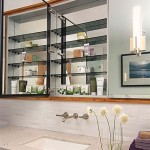How to Fix Scratched Mirror Glass
Scratched mirror glass can be an unsightly blemish, detracting from the overall aesthetic of a bathroom, dressing room, or any space where a mirror is prominently displayed. While deep scratches often necessitate professional repair or mirror replacement, superficial scratches can often be addressed with DIY methods. This article provides a comprehensive guide to assessing the damage, selecting the appropriate repair techniques, and executing those techniques effectively to restore the clarity and appearance of your scratched mirror glass.
Understanding the depth and severity of the scratch is paramount before attempting any repair. Scratches vary in depth, from hairline abrasions to deeper gouges. Attempting to repair a deep scratch with a method designed for minor imperfections can lead to further damage or an unsatisfactory result. A close visual inspection, coupled with carefully running a fingernail across the scratch, can help determine its depth. If the fingernail catches significantly, the scratch is likely too deep for DIY methods.
Before undertaking any repair, it is crucial to gather the necessary materials. The specific materials required will depend on the chosen method, but some common items include: cleaning solutions (glass cleaner, mild soap and water), microfiber cloths, painter's tape, cerium oxide polishing compound, a polishing pad or cloth (felt or microfiber), a rotary tool or drill (optional, but recommended for larger areas), and distilled water.
Cleaning and Preparation
Proper preparation is essential for achieving optimal results. The first step is thoroughly cleaning the mirror surface to remove any dirt, dust, or debris. This will prevent these particles from being ground into the glass during the polishing process, potentially causing further scratches. Use a glass cleaner or a mild solution of soap and water, applied with a clean microfiber cloth. Ensure the surface is completely dry before proceeding.
Next, use painter's tape to carefully mask off the area surrounding the scratch. This will protect the surrounding mirror glass from accidental abrasion during the polishing process. Apply the tape close to the scratch, ensuring that the edges are securely adhered to the mirror surface. If you are working with a large mirror or multiple scratches, consider masking off larger sections to prevent accidental damage.
Adequate lighting is also critical for successful scratch repair. Use a bright, direct light source to illuminate the scratched area. This will allow you to clearly see the scratch and monitor your progress as you polish. A magnifying glass can also be helpful for examining the scratch in detail.
Minor Scratch Repair Using Polishing Compound
For hairline scratches and minor surface imperfections, a polishing compound such as cerium oxide can be effective. Cerium oxide is a fine powder that, when mixed with water, creates a mild abrasive paste capable of gently polishing the glass surface and removing shallow scratches.
To prepare the cerium oxide paste, mix the powder with distilled water according to the manufacturer's instructions. The consistency should be similar to a thick cream. Apply a small amount of the paste to a polishing pad or cloth, ensuring that the pad is slightly damp but not overly saturated. A felt polishing pad is often preferred for glass polishing due to its fine texture and abrasive properties.
Using gentle, circular motions, rub the polishing pad over the scratched area. Apply consistent pressure, but avoid pressing too hard, as excessive pressure can generate heat and potentially damage the glass. Work the paste into the scratch for several minutes, periodically checking your progress. If the paste starts to dry out, add a small amount of distilled water to keep it moist.
After polishing for a sufficient amount of time, remove the excess paste with a clean, damp microfiber cloth. Inspect the area to see if the scratch has been reduced or eliminated. If the scratch is still visible, repeat the polishing process. Multiple applications may be necessary to achieve the desired results. It's important to remember that this method is best suited for minor imperfections and may not completely eliminate deeper scratches.
Using a Rotary Tool for Larger Areas
For larger scratches or when dealing with a significant number of minor scratches across a larger area of the mirror, a rotary tool or drill equipped with a polishing attachment can be more efficient. This method utilizes the same cerium oxide polishing compound, but the rotary tool provides more consistent and controlled polishing action.
Attach a polishing pad specifically designed for glass polishing to the rotary tool or drill. Ensure that the pad is securely fastened and that the tool is set to a low speed. High speeds can generate excessive heat and damage the mirror glass. Exercise caution when using a rotary tool, as it can easily cause further damage if not handled properly.
Apply a small amount of cerium oxide paste to the polishing pad and gently polish the scratched area using slow, overlapping strokes. Maintain consistent pressure and avoid dwelling on any one spot for too long. Monitor the temperature of the glass to prevent overheating. If the glass becomes too hot to touch, stop polishing and allow it to cool before continuing.
As with the manual polishing method, periodically check your progress and remove any excess paste with a clean, damp microfiber cloth. Repeat the polishing process as needed until the scratch is reduced or eliminated. Once you are satisfied with the results, thoroughly clean the entire mirror surface to remove any remaining residue.
Addressing Deeper Scratches
Deeper scratches present a more significant challenge and may not be entirely repairable with DIY methods. While cerium oxide polishing can help to reduce the visibility of deeper scratches, it is unlikely to completely remove them. Attempting to aggressively polish a deep scratch can lead to distortion of the mirror surface, creating a “wavy” or uneven appearance.
For deeper scratches, a multi-step polishing process may be necessary. This involves starting with a coarser abrasive compound to remove a small amount of glass from around the scratch and then gradually working your way up to finer polishing compounds to smooth and refine the surface. This process requires specialized tools and techniques and is best left to experienced professionals.
Alternatively, consider consulting with a glass repair specialist. They may be able to fill the scratch with a clear resin or other material and then polish the surface to restore its clarity. This method can be more effective at concealing deeper scratches and preventing further damage.
In some cases, the most cost-effective and practical solution may be to replace the mirror. This is particularly true for mirrors with deep or extensive scratches, as attempting to repair them can be time-consuming and may not yield satisfactory results. When replacing a mirror, consider purchasing a high-quality mirror with a protective coating to prevent future scratches.
After any repair, clean the mirror thoroughly with a glass cleaner and a microfiber cloth to remove any remaining residue. Inspect the repaired area under bright light to ensure that the scratch has been adequately addressed. If you are not satisfied with the results, consider consulting with a professional glass repair service.

5 Tricks To Remove Scratches From A Bathroom Mirror Helping You Find Your Own Definition Of Beauty Style

How To Repair Mirror Scratches A Guide Glass Doctor

How You Can Remove Light Scratches From Your Mirror Glass Ace

How To Remove Scratches From A Mirror Scratched Repair

How To Repair Scratches On The Back Of A Mirror Hometalk

How To Remove Light Scratches From Pretty Much Anything Stratagem

Can I Fix A Scratched Mirror
Full Guide How To Remove Scratches From A Car Mirror Micmirror

How Can I Remove Scratches From A Mirror Hometalk

How To Repair A Scratch In Reflective Coating On Mirror Hunker
